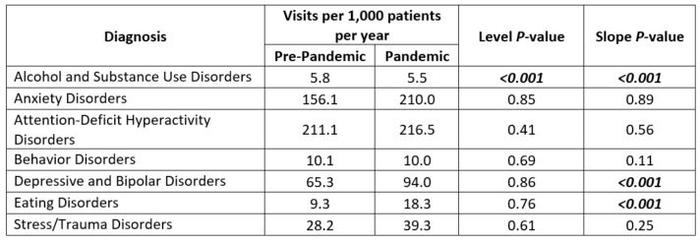DENVER, April 22, 2022 – A new study describes the impact of the COVID-19 pandemic on pediatric primary care mental health visits. Findings from the study will be presented during the Pediatric Academic Societies (PAS) 2022 Meeting, taking place April 21-25 in Denver.
Researchers with Boston Children’s Hospital found that visits to pediatric primary care offices for eating disorder and depressive and bipolar disorder began increasing significantly at the start of the pandemic period, whereas alcohol and substance use disorder visits immediately decreased in frequency and were less frequent over time.
These results reveal an increased burden of mental health care provision in the primary care office since the start of the pandemic and highlight the importance of screening for, provisionally diagnosing, and managing youth mental health conditions in primary care during periods of social isolation. Additional research is needed to further understand the impact of COVID-19 on youth mental health.
“We aimed to describe the impact of the COVID-19 pandemic on pediatric mental health, specifically in terms of visits to primary care,” said Jane Bittner Gould, MPH, CPH, senior project manager at Pediatric Physicians’ Organization at Children’s. “We conducted an interrupted time series analysis of in-network visits among our large pediatric network in Massachusetts. Our findings reveal significant changes in the pattern of visits to primary care offices for mental health conditions in children and adolescents: most notably, striking increases in visits for eating disorders and mood disorders during the pandemic period. Conversely, visits for alcohol and substance use disorders declined during the pandemic period.”
The self-reported mental health impacts of the COVID- 19 pandemic on adults include increased stress, anxiety, and depression. Research on the impact of pandemic-related social changes on the mental health of children and adolescents is more limited.
Ms. Gould will present “Impact of the Coronavirus Disease 2019 Pandemic on Mental Health Visits in Pediatric Primary Care” on Sunday, April 24 at 8:30 a.m. MDT. Reporters interested in an interview with Ms. Gould should contact PAS2022@piercom.com.
The PAS Meeting connects thousands of pediatricians and other health care providers worldwide. For more information about the PAS Meeting, please visit www.pas-meeting.org.
###
About the Pediatric Academic Societies Meeting
The Pediatric Academic Societies (PAS) Meeting is the premier North American scholarly child health meeting. The PAS Meeting connects thousands of pediatricians and other health care providers worldwide. The PAS Meeting is produced through a partnership of four pediatric organizations that are leaders in the advancement of pediatric research and child advocacy: American Pediatric Society, Society for Pediatric Research, Academic Pediatric Association and American Academy of Pediatrics. For more information, please visit www.pas-meeting.org. Follow us on Twitter @PASMeeting, Instagram PASMeeting and #PAS2022, and like us on Facebook PASMeeting.
—
Abstract: Impact of the Coronavirus Disease 2019 Pandemic on Mental Health Visits in Pediatric Primary Care
Topic
General Pediatrics: All Areas
Presenting Author
Jane C. Bittner Gould, MPH, CPH
Organization
Boston Children’s Hospital
Background
The self-reported mental health impacts of the coronavirus disease 2019 (COVID- 19) pandemic on adults include increased stress, anxiety, and depression. Research on the impact of pandemic-related social changes on the mental health of children and adolescents is more limited.
Objective
To describe the impact of the COVID-19 pandemic on pediatric primary care mental health visits.
Design/Methods
We used electronic health record data from a pediatric primary care network in Massachusetts to perform an interrupted time series analysis on the rate of pediatric mental health visits before and after the start of the COVID-19 pandemic. Three time periods were defined: the pre-pandemic period (Jan 2019-Feb 2020); the emergency pandemic period (Mar 2020-May 2020); and the pandemic period (Jun 2020-Sep 2021). We assessed pediatric primary care visits, conducted in- person or via telehealth, with network physicians, nurse practitioners, and physician assistants with any of the following visit diagnoses: alcohol and substance use disorders; anxiety disorders; attention-deficit hyperactivity disorders; behavior disorders; depressive and bipolar disorders; eating disorders; and stress/trauma disorders.
Results
A significant increase in slope (P
Conclusion(s)
Visits to pediatric primary care offices for eating disorder and depressive and bipolar disorder began increasing significantly at the start of the pandemic period, whereas alcohol and substance use disorder visits immediately decreased in frequency and were less frequent over time. These results reveal an increased burden of mental health care provision in the primary care office since the start of the pandemic and highlight the importance of screening for, provisionally diagnosing, and managing youth mental health conditions in primary care during periods of social isolation. Additional research is needed to further understand the impact of COVID-19 on youth mental health.
Tables and Images
Table 1. Rates of Pediatric Mental Health Visit Diagnoses in the Pre-Pandemic and Pandemic Periods, with an ITS Analysis of Level and Slope Changes
Abbreviation: ITS = Interrupted time series
PAS_Table 1. Rates of Pediatric Mental Health Visit Diagnoses.JPG
Figure 1. Monthly Rates of Seven Pediatric Mental Health Visit Diagnoses, January 2019-September 2021
Symbol: ∆ = Change. The white area represents the pre-pandemic (Jan 2019-Feb 2020); the dark gray represents the emergency pandemic period (Mar 2020-May 2020); and the light gray represents the pandemic period (Jun 2020-Sep 2021). P-values bolded in red highlight statistically significant changes.
PAS_Figure 1. Monthly Rates of Seven Pediatric Mental Health.png
















































